Understanding Mandalas: History and Modern Use
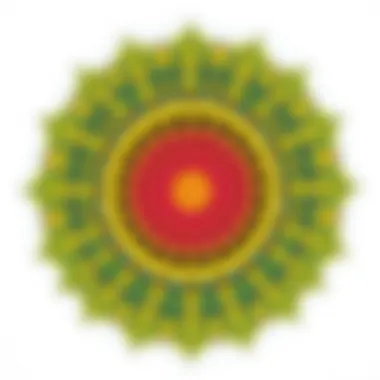
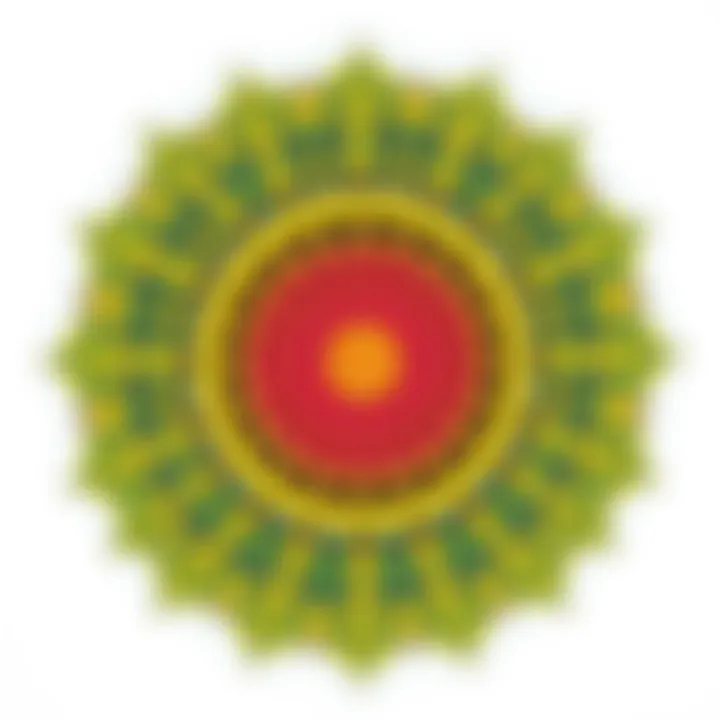
Intro
Mandalas have fascinated people across the world for centuries. These intricate designs, often circular in form, carry profound meanings rooted in spirituality, art, and culture. Their origins can be traced back to ancient civilizations, where they served not only as spiritual symbols but also as tools for meditation and self-discovery. From Hindu and Buddhist traditions to modern interpretations in various cultures, mandalas are more than mere decorations; they encapsulate a journey of understanding and expression.
In this exploration, we aim to peel back the layers of meaning behind mandalas, examining how they are both a reflection of their cultural heritage and a canvas for personal expression. This article will guide you through historical origins, cultural significance, and contemporary applications, offering valuable insights into both traditional and modern perspectives. Alongside this, we will delve into practical applications, equipping you with the knowledge to create and utilize mandalas in educational settings.
So, whether you’re a curious learner, an educator seeking innovative teaching tools, or simply someone hoping to deepen your understanding of this intricate art form, this piece will illuminate the paths you can take with mandalas while inspiring creativity in your own world.
Back in ancient times, mandalas were often drawn in sand or crafted with natural materials, serving as temporary creations that connected individuals to a sense of peace and mindfulness. They are much more than decorative art; they hold the ability to foster focus, clarity, and a greater sense of spirituality. Let's dive into the world of mandalas and uncover their complexities, cultural relevance, and avenues for creative engagement.
Preface to Mandalas
Mandalas are more than just intricate designs; they are windows into rich histories, cultures, and philosophical thoughts that span across various societies. Understanding what mandalas encompass can give insight into human creativity, spirituality, and even psychology. In this section, we’ll highlight how mandalas serve not only as art but as powerful tools for expression, meditation, and connection to both self and community.
Definition and Characteristics
At their core, mandalas are geometric configurations that represent the universe's wholeness. They often feature a central point surrounded by a series of shapes that radiate outward in symmetric patterns. One of their key characteristics is symmetry, which can evoke a sense of balance and peace when observed. The vibrant colors and complex patterns can draw one in, creating an almost hypnotic effect that encourages a meditative state.
Often used in various spiritual traditions, mandalas possess a dual nature—they're both artistic and functional. They can be created using a variety of materials, from colored sand in Tibetan traditions to digital formats in modern art. This varied ability to shape them adds to their allure and versatility.
Historical Context
Origins in Ancient Cultures
Mandalas trace their origins back to ancient cultures, where they served key spiritual and ceremonial functions. In Hinduism and Buddhism, for example, these designs were— and still are—considered sacred. They are often used in temple art or as guides for meditation, connecting practitioners with spiritual realms. Their recognizable circular form symbolizes the cycle of life, reinforcing beliefs in both creation and destruction. This aspect makes them a beneficial inclusion in discussions about spirituality, meditation, and art, portraying how our ancestors comprehended the universe.
Unique features such as the meticulous construction of these patterns require patience and precision, which also embodies a larger concept— the importance of the journey, not just the destination. This lens encourages personal reflection, making the exploration of mandalas both a popular and beneficial choice within spiritual and artistic contexts.
Development Through Different Eras
As cultures evolved, so did the art of creating mandalas. From the ancient times of India to the influence of mandalas in contemporary art, this evolution represents a blend of tradition and innovation. During the Middle Ages, the use of mandalas in Western art emerged, blending with Christian iconography where intricate rose windows, for example, echoed the circular forms of earlier Eastern designs. This fluidity and adaptation highlight the cultural exchanges across time.
The key characteristic of mandalas developing through different eras is that they hold diverse meanings depending on the cultural context. Their capacity to transcend boundaries positions them as a subject of continued fascination and study. However, one must consider how modern interpretations can sometimes diverge from original spiritual significance, which raises questions about authenticity and intention in creating mandalas today.
Cultural Significance
Mandalas in Eastern Religions
In Eastern religions, particularly in Buddhism and Hinduism, mandalas serve crucial roles in rituals and meditation practices. They are seen as representations of the cosmos, helping practitioners visualize profound spiritual concepts. The mandala's intricate patterns guide meditation, inviting the mind to focus and deepen spiritual experiences. This characteristic makes them especially relevant for understanding mindfulness better, emphasising their therapeutic capabilities.
Mandalas in Western Art
In Western contexts, mandalas have made their mark across various artistic movements. Artists, from the likes of Joan Miró to contemporary digital creators, have employed mandala motifs to explore themes of identity and the subconscious. Their adaptability in modern art reflects a cultural fascination with self-expression and the deep human need to make sense of one's place in the universe. The rich imagery and symbolism in these works promote discussions about mental health, creativity, and artistic exploration, further affirming their significance in contemporary dialogues.
Mandalas Across Cultures
Mandalas hold a prominent place in various cultures around the world, showcasing not only the artistic expression but also their spiritual significance. Each cultural iteration serves as a vital link to its respective beliefs, practices, and societal structures. By examining how mandalas differ across cultures, we gain insights into the universal themes of creation, harmony, and reflection intrinsic to human experience.
Buddhist Mandalas
Symbolism and Spiritual Meaning
Buddhist mandalas are unique in their design and purpose. They often symbolize the universe and the mind’s journey towards enlightenment. When one gazes at a Buddhist mandala, it is not just a visual delight; it carries profound layers of meaning. For instance, the circular layout often represents cyclic existence, while the intricate geometric shapes highlight the interconnectedness of all things.
A key characteristic of these mandalas is their use of symmetry, a feature that speaks to balance and harmony within chaos. This emphasis on balance is a pivotal aspect of Buddhist philosophy, thoroughly reflected in the mandala’s construction. The meditative act of creating or contemplating a mandala can inspire mindfulness, making it a beneficial choice for those seeking tranquility and insight in this article. However, the downside may lie in the in-depth study required to fully understand their significance, which might intimidate some.
Ritual Use and Creation
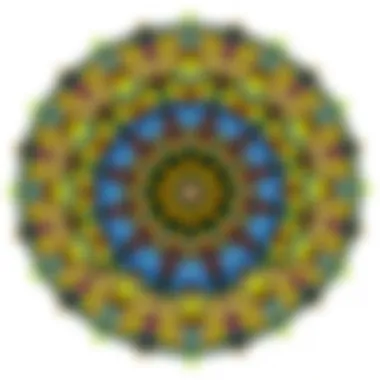
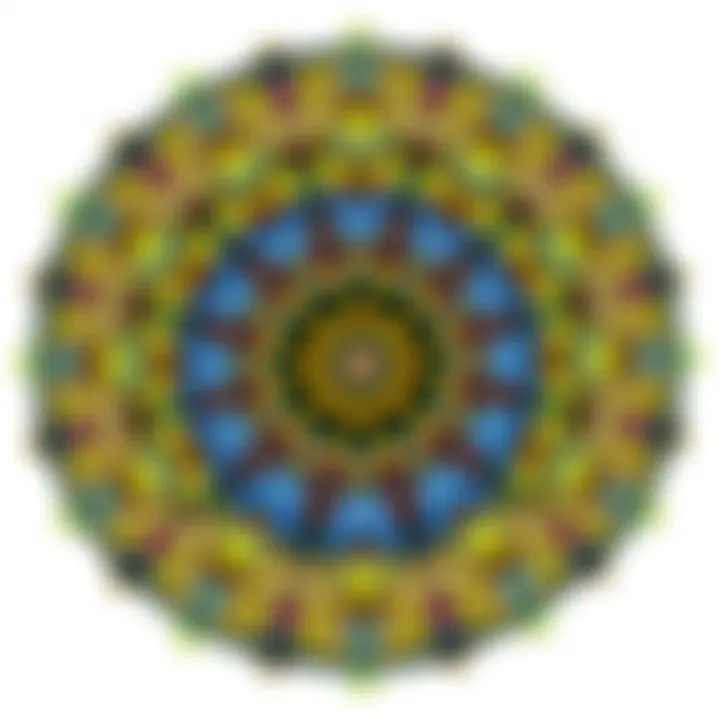
The creation of Buddhist mandalas is as much a ritual as it is an artistic endeavor. While some mandalas are sand paintings made during ceremonies, others are painted or drawn as a means of calming the mind and facilitating meditation. The act of constructing a mandala often serves as a form of spiritual practice, guiding individuals towards a meditative state.
One distinctive feature of this practice is the ritualistic use of color and form, where specific hues and designs hold unique meanings. This aspect deeply enriches the practice of creating a mandala, making it a profound and communal experience. Still, the temporary nature of sand mandalas poses a philosophical challenge; once completed, they are destroyed to signify the impermanence of life, which may evoke sadness for some participants.
Hindu Mandalas
Geometric Patterns and Designs
Hindu mandalas are often composed of intricate geometric shapes that serve both aesthetic and spiritual purposes. Unlike some other cultures, the focus here is heavily rooted in cosmology and the divine. These patterns often represent the universe's structure, drawing connections to sacred texts and deities.
A characteristic element of Hindu mandalas is their elaborate detailing, showcasing the adept skills of the artist. Such remarkable designs are beneficial for this article as they allow for a deeper understanding of how art can embody spirituality. However, these designs can be complex and may require specific knowledge or training to create accurately, which could be a barrier for casual artists.
Role in Meditation Practices
In Hindu tradition, mandalas are not just decorative; they are tools for meditation. Practitioners use them to focus their thoughts and deepen their spiritual awareness. The circular nature of mandalas helps concentrate the mind, often assisting in visualizations during meditation.
Their role in meditation reflects a key characteristic of focusing energy and intention. This focus mechanism makes them a popular choice for spiritual seekers, as using a mandala can create a sacred space conducive to mindfulness. Still, some may find it challenging to maintain focus strictly, especially if they are not accustomed to meditation, which could lessen its effectiveness.
Native American Mandalas
Cultural Heritage and Storytelling
Among various Indigenous cultures in North America, mandalas serve as conduits for storytelling and preserving cultural heritage. These mandalas can depict life stories, tribal history, and spiritual pathways, blending art with a narrative function. They often function as visual diaries, establishing connections to ancestors and community narratives.
A significant feature of Native American mandalas is their incorporation of nature and elements that reflect the surrounding landscape. This aspect gives them a firm grounding in cultural identity, making them a thoughtful inclusion in this article. However, as these stories are often deeply personal and rooted in specific cultural practices, they may not always be accessible or easily translated for outsiders.
Use in Healing and Ceremonies
Native American mandalas play crucial roles in rituals and healing ceremonies. They are often used to promote balance and harmony within individuals and the community. Each mandala is imbued with spiritual significance, as its creation can invoke connection with the spiritual realm. For instance, during ceremonies, mandalas might be incorporated into rituals to bolster healing intentions.
This usefulness is marked by a strong connection to nature's cycles and human experiences. Their contextual nature can enhance practical healing methods, showcasing the interplay between art and spirituality. However, integrating these mandalas outside their traditional context might lead to misinterpretations, which can dilute their original meaning and impact.
"Mandalas are not just art; they are pathways to understanding the universe and ourselves."
As we see, mandalas across cultures each reveal distinct stories and teachings. Their diverse forms and uses serve as testament to the rich tapestry of human expression and the myriad ways individuals connect with the world around them.
Artistic Expressions of Mandalas
Artistic expressions of mandalas showcase the diverse ways in which this intricate symbol can be interpreted and manifested. The significance of mandalas goes beyond mere aesthetics; they serve as a bridge between the inner and outer worlds, allowing artists and viewers alike to connect with deeper aspects of consciousness. In this section, we will explore various techniques, materials, and modern adaptations that give mandalas their unique character, creating a richer understanding of their relevance in both historical and contemporary contexts.
Techniques and Materials
Traditional Hand-Made Mandalas
Traditional hand-made mandalas are rooted in ancient practices, often created using materials like colored sand, paint, or fabric. Artists devote time and focus to meticulously arranging elements, ensuring that every line and color forms a cohesive whole. This craftsmanship is a hallmark of traditional mandalas, reflecting patience and spiritual discipline.
A key characteristic of these hand-crafted pieces is their impermanence; sand mandalas, for instance, are often destroyed shortly after completion. This serves as a poignant reminder of the transient nature of life. The choice to create a hand-made mandala is often viewed as a spiritual journey, allowing the creator to enter a meditative state, which can lead to a variety of therapeutic benefits such as stress relief and enhanced focus.
However, the drawbacks might include the time-consuming process and the necessity for skillful hand movement, which could be intimidating for beginners. Still, the introspective journey one embarks on while creating these mandalas is invaluable.
Digital Mandalas in Contemporary Art
In contrast to traditional practices, digital mandalas leverage technology to create intricate designs quickly and efficiently. They can be crafted using graphic design software, allowing for unique patterns and vibrant color palettes that may not be feasible with traditional techniques. This modern take enables artists to experiment with dimensions and symmetry in ways that were previously limited by physical materials.
A defining feature of digital mandalas is their repeatability; once created, they can be reproduced with exact precision, making them accessible to a broader audience. The ease of sharing these designs on social media platforms broadens their reach and appreciation, as one can quickly showcase their creations online.
Nonetheless, relying on digital tools can detract from the meditative aspect traditionally associated with mandala making, leading some purists to question if these contemporary adaptations truly capture the essence of the original practices.
Mandalas in Modern Art
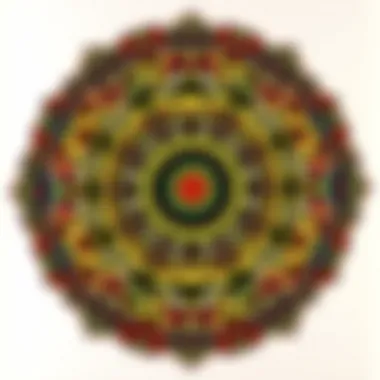
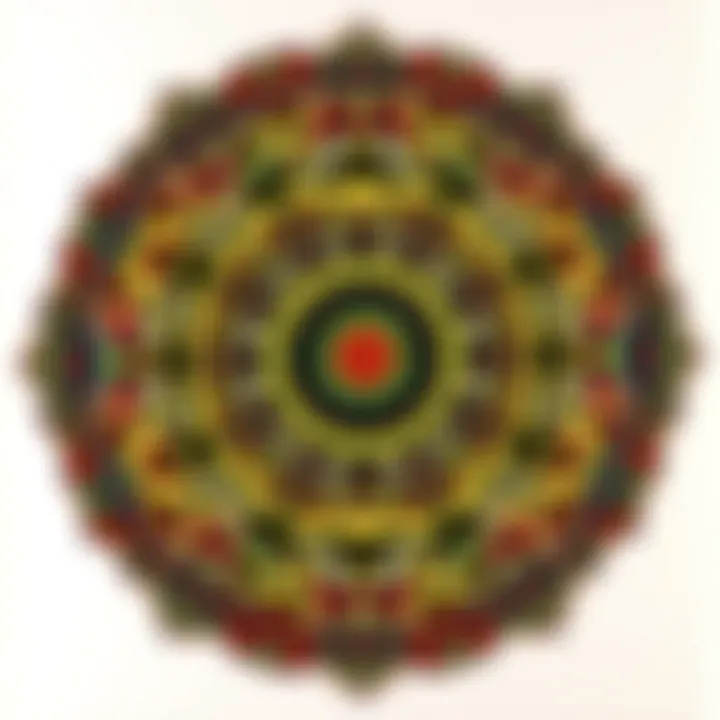
Influence of Psychedelic Art
The influence of psychedelic art on mandalas cannot be understated. Emerging during the late 1960s and early 1970s, this movement brought forth a new appreciation for vivid colors and complex patterns, which are fundamental characteristics of mandalas. Artists like Peter Max embraced swirling forms and repetitive motifs, echoing the meditative and enlightening qualities of traditional mandalas.
This blend of contrast between chaotic energy and serene balance is a hallmark of psychedelic mandalas. They appeal particularly to younger generations who seek deeper meaning in art and use visual stimulation to evoke feelings of exploration and self-discovery.
Yet, some may find that while these art forms are striking, they can lose the spiritual aspect found in more traditional designs, thus sparking a debate about purpose and meaning in visual art.
Integration into Popular Culture
In recent years, mandalas have found their way into popular culture through various mediums, including tattoos, fashion, and home décor. The integration of mandalas into mainstream practices has made them a symbol of healing and balance for many. This widespread recognition reflects a shift in collective consciousness, where people view mandalas as conduits for personal growth and reflection.
One unique feature of their presence in popular culture is their versatility; mandalas can be simplified for quicker interpretations, adapting to fit various artistic styles. They can range from delicate illustrations in children's coloring books to bold designs featured on clothing.
However, there is a downside to this popularity — the risk of commodification. When mandalas are reduced to mere decoration, their profound significance can become diluted. This could potentially lead individuals away from the deeper meanings inherent in the mandala's traditional forms.
Meanings Behind Different Patterns
The patterns that comprise mandalas are not random; each element holds specific meanings that resonate across cultures and spiritual practices. For instance, concentric circles often symbolize unity and wholeness, while intricate geometric shapes can represent the universe and its interconnectedness. … This final section would delve deeper into these meanings, enhancing understanding and appreciation for the symbolism present in various mandala forms.
Psychological and Educational Uses
Mandalas serve not just as art forms but are also pivotal in psychological and educational practices. Their unique designs can create an engaging atmosphere for learning and self-discovery, making them handy tools for teachers, caregivers, and anyone interested in personal development. By understanding the psychological and educational uses, one can appreciate how these intricate patterns impact wellbeing and creativity.
Mandalas and Mindfulness
Mandalas and mindfulness are closely intertwined, offering deep therapeutic benefits. When individuals engage in creating or coloring mandalas, they often enter a state of flow—where time seems to stand still, and focus sharpens. This experience can be particularly helpful in the context of therapy, providing a visual and tactile form of expression for feelings that may be hard to convey through words.
Therapeutic Benefits
The therapeutic benefits of mandalas aren't merely anecdotal. Studies suggest that engaging with these designs can significantly reduce anxiety and depression.
- Key characteristic: The repetitive nature of mandala creation promotes calmness, leading to enhanced emotional regulation.
- Why therapeutic: Many find mandalas a natural fit in art therapy settings, helping individuals express their thoughts and feelings creatively. This unique feature allows for a nonverbal outlet that can be especially beneficial for children or individuals with communication difficulties.
- Advantages: Using mandalas in therapy sessions makes it easier for facilitators to connect with clients who might struggle to articulate their emotions. However, it’s important to note that while creating mandalas can be beneficial, it may not be a standalone solution for severe psychological issues.
Stress Relief and Focus Techniques
Stress relief techniques that incorporate mandalas can be exceptionally effective. Many people find that the act of focusing on a mandala's geometric shapes can help ground them during chaotic moments.
- Key characteristic: The act of coloring or drawing mandalas engages both the mind and the body, which helps in relieving tension.
- Why it works: This strategy not only eases stress but also improves concentration. The steady rhythm of repeated patterns in mandalas provides a soothing focus, making it a popular method for people looking to enhance their mindfulness practice.
- Advantages: Moreover, this technique can also be a simple method for educators to incorporate into classroom settings, helping students improve their focus. On the flip side, it may not resonate with every individual, as some might find structured patterns limiting.
Mandalas in Education
In the educational landscape, mandalas find their place as powerful tools to boost creativity and engagement among children. The educational applications of mandalas are diverse and can yield profound insights into child development and learning processes.
Enhancing Creativity in Children
Using mandalas to enhance creativity in children offers an avenue for personal expression while honing fine motor skills. This unique aspect invites imagination and original thought.
- Key characteristic: Children can adapt patterns to reflect their personal experiences or feelings, making the creation highly individualistic.
- Why it’s beneficial: Integrating mandala art into lessons cultivates an environment where children feel safe to express their creativity. It also encourages them to think outside the box, fostering problem-solving skills.
- Advantages: This approach to learning can help children break away from traditional educational constraints, allowing their innate creativity to blossom. However, strict guidelines around what a mandala must look like can limit exploration and creativity.
Using Mandalas to Teach Geometry
Mandalas can also serve as effective tools for teaching geometry. With their intricate shapes and patterns, they make abstract concepts more tangible and relatable for students.
- Key characteristic: They encompass a variety of geometric principles, allowing students to visualize and understand concepts such as symmetry, angles, and shapes directly.
- Why it works: This practical application aids in bridging the gap between theoretical knowledge and real-world visualization. When children create mandalas, they're not just art projects; they are lessons in design and math.
- Advantages: Engaging with mandalas fosters a collaborative learning approach, as students can work together to create larger pieces. However, it’s important for educators to guide discussions to ensure the mathematical concepts are not lost amidst the creativity.
Overall, the integration of mandalas in psychological settings and educational frameworks reveals their multifaceted benefits. They are not just aesthetically pleasing; they are powerful tools for personal expression and cognitive development.
Creating Your Own Mandala
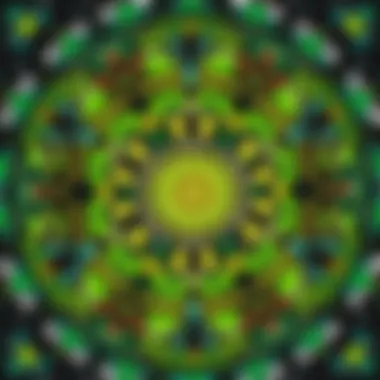
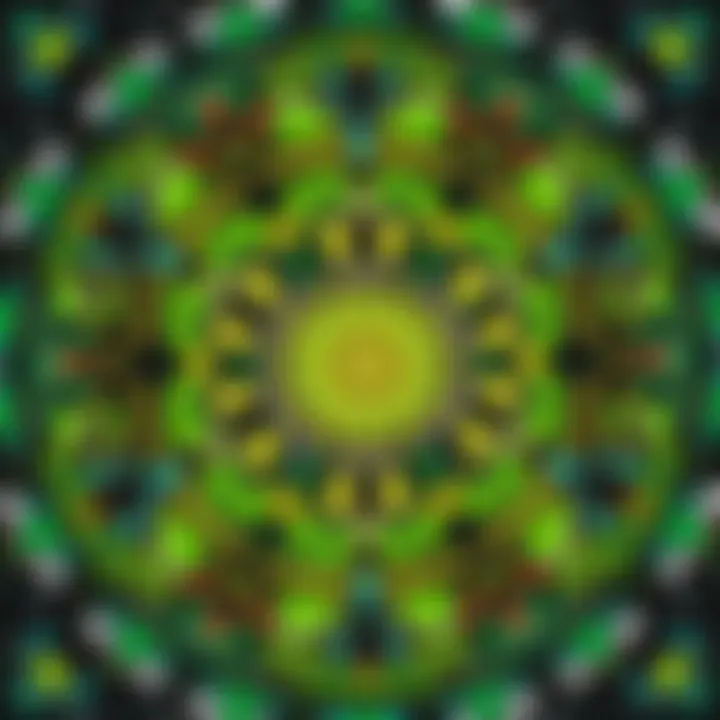
Creating your own mandala is a journey into personal expression and creativity. It’s not just about filling a page with colors and shapes; it’s an exploration of one’s self. This process can help unveil thoughts and emotions, often leading to a deeper connection with one's inner landscape. Engaging with mandalas can be both a therapeutic outlet and a delightful hobby.
Steps to Design a Personal Mandala
Choosing Your Design Style
Selecting a design style is crucial as it sets the tone for your mandala. You can opt for geometric, organic, or a blend of both styles. A geometric style, for instance, allows for precision and symmetry which some find calming. Organic designs, on the other hand, can be spontaneous and whimsical, reflecting your emotional state at the moment. The choice between these styles can influence how you feel during the creating process.
The uniqueness of your selected design style is in its direct reflection of your personality. If you lean towards tranquility, geometric shapes may resonate with you. Conversely, if you prefer a more free-spirited approach, organic lines might be beneficial. But beware—a lack of direction in your design can lead to frustration, so find a balance that suits you.
Selecting Colors and Tools
The colors and tools used in your mandala play a significant role in its overall vibe. You could pick colored pencils, markers, or paints, each offering a different texture and depth to your artwork. Moreover, the psychological impact of colors is well-documented. For example, blue often exudes calmness while red can invoke energy.
Unique tools, like watercolor brushes or even simple crayons, can offer varied results. Choosing the right colors can infuse your mandala with feelings you want to express. But it’s important to consider your familiarity with these tools; trying something completely new might yield unexpected outcomes, for better or worse.
Tips for Effective Creation
Finding Inspiration in Nature
Nature can be a treasure trove of inspiration when creating mandalas. The intricate patterns found in leaves, flowers, and landscapes can be translated into your work. For instance, the circular shape of a sunflower or the spiraled structure of a pine cone can spark ideas that lead to something visually stunning. Nature has its own way of commanding attention, and incorporating these elements can anchor your creation in something larger than oneself.
Using nature as a muse could also enhance your connection to the environment and spur creativity. Just be cautious; while nature is a fantastic source, it is also vast, and it can sometimes be overwhelming to choose which elements to incorporate.
Using Symmetry and Repetition
Symmetry and repetition are key principles when making a mandala. They create a sense of balance and harmony, guiding the viewer’s eyes through the design. For example, repeating a simple motif—like a petal or a dot—throughout your mandala can evoke feelings of stability and peace.
These factors are beneficial as they assist in creating visual cohesion. However, over-reliance on symmetry can sometimes feel a bit rigid. Instead, consider intertwining some asymmetry to let your creativity breathe. A balance of order and chaos often leads to the most engaging results.
"Creating your own mandala can unlock a pathway of self-discovery, leading you not just to artistic expression but also to deeper reflections about your inner self."
To wrap it up, designing your own mandala is a rewarding endeavor that fosters creativity and mindful reflection. By carefully choosing your design style, colors, and tools—alongside tips for effective creation—you’ll not only enhance your artistic abilities but also deepen your understanding of this beautiful tradition.
Finale and Reflections
Reflecting on the journey through the world of mandalas, it becomes apparent just how vital this concept is. Mandalas are not just intricate designs; they are a bridge between the past and present, linking cultures across time and space. From their origins in ancient spiritual practices to their roles in modern mindfulness and education, mandalas offer a rich tapestry of meanings and uses.
Their enduring appeal lies in their universal nature. People from all walks of life resonate with the idea of circles and intricate patterns. The symmetry and balance evident in mandalas can evoke a sense of calm and order, making them particularly valuable in today’s fast-paced world. Moreover, the act of creating a mandala can be therapeutic, promoting focus and stress relief. This connection to mental well-being is crucial as society becomes more aware of the importance of mental health.
In terms of educational value, mandalas serve as a creative outlet for children and adults alike. They can enhance cognitive skills, such as geometry and spatial reasoning, while also fostering creativity. This is especially beneficial in classroom settings, where children can express themselves artistically while learning important concepts. Encouraging students to explore mandalas not only makes learning more engaging but also helps them appreciate the intersection of art and math.
"Mandalas remind us that we are all part of a larger whole, connected through design, culture, and shared experience."
As we conclude, it is worth noting that engaging with mandalas can spark new interests. They are not merely art forms, but pathways to deeper cultural understanding and personal reflection. For those intrigued by their significance, the exploration does not need to end here. Each design holds stories waiting to be uncovered and understood.
The Enduring Appeal of Mandalas
The perpetual fascination with mandalas comes from their intrinsic qualities that speak to both the artistic and spiritual sides of human experience. When one looks at a mandala, be it painted, drawn, or crafted from nature, there’s a resonance that can almost take one out of the ordinary flow of time. This sensation can be attributed to their mathematical structure and the way they radiate outward, inviting the observer to delve deeper into their design.
Mandalas symbolize harmony and unity. They often encapsulate the idea that all things are interconnected. As people engage in creating or viewing mandalas, they may find themselves feeling a sense of peace that can seem elusive in daily life. The repetitive patterns can induce a meditative state, encouraging mindfulness and attention to the present moment.
In various cultures, mandalas are used in rituals and spiritual practices, further solidifying their importance. For instance, in many Buddhist traditions, creating a sand mandala is a significant ritual that embodies impermanence, requiring patience and mindfulness. After completion, these vibrant creations are often dismantled as a reminder of the transient nature of life.
It’s essential to recognize how the appeal of mandalas extends beyond mere aesthetics; they offer a canvas for individual expression and communal experience alike.
Encouraging Continued Exploration
Exploration of mandalas doesn’t have to stop at mere observation or creation. To genuinely appreciate their depth, a continuous journey into their significance and applications is encouraged. Engaging with mandalas may lead one towards studying their historical contexts or delving into the various techniques used across cultures, adding layers to one’s understanding.
For those wanting to learn more, there are numerous resources available. Books, online courses, and community workshops often provide opportunities for practical engagement. Websites such as Wikipedia and Britannica offer articles that detail the historical and cultural backgrounds of mandalas, while forums like Reddit allow for discussions and shared experiences among artists and enthusiasts.
Creating personal mandalas can also open doors to deeper insights. By experimenting with colors, patterns, and designs, individuals can discover their creative outlets while tapping into emotional and spiritual aspects of their lives.
Encouragement lies in the idea that every mandala created or observed is a gateway into self-discovery and cultural appreciation. The journey might begin with simple shapes and colors, but it can unfold into a world of endless exploration, connection, and meaning.















